Friday, 4 June 2010
Distance 21 km
Duration 4 hours 5 minutes
Ascent 393 m, descent 428 m
Map 41 of the TOP 100 blue series (or Map 147 in the new lime-green series)
Topoguide (ref. 6542) Sentier vers Saint-Jacques-de-Compostelle via Vézelay

The farmhouse was silent when we crawled out of the tent about 6:45 am. We sat on a rustic bench in the early sunshine to strap up our array of blisters and eat our muesli, with the last of the bananas from Éguzon.
A pair of large tame rabbits was nibbling the grass nearby. They lived in a hole set into a low retaining wall beside the lawn and had been let out for a morning browse.
As we were leaving, the younger woman appeared and showed us a quick way to get to the road by going down a path behind the house. We met her mother coming up with a basket, and found her still confused about whether she should address us in French or in German.

From the gîte it was much shorter to take this little road to the bridge at le Dognon than to go back and join the GR. Even so, it seemed an age until we got there. The country was hilly and I found the going arduous.
As we came down to the river, we passed a camping ground stretched out far along the bank, but practically empty. We could only hope that business would pick up when the school holidays began.
The river Taurion was wide and smooth between its wooded banks, and at the bridge there was an imposing hotel-restaurant looking out over the water.

Normally we would have rushed towards it, but we had been assured by our hostesses last night that there was a bar in le Châtenet-en-Dognon, only an hour further on.
Crossing the bridge, we were once again on the GR (and on the pilgrimage), and soon turned off the road up a steep forest track. Even though it was muddy and slow to walk on, it was uncharacteristically direct, much more so than the road.
At Organac the track made a sharp bend around a high-walled château crawling with workmen. Apparently it was being converted into a holiday camp. A kilometre after that we left the GR as it skirted the village and went in to the main street of le Châtenet.
Immediately opposite was the promised bar with doors flung open, a joyful sight. Before going in, we looked down the street and saw a boulangerie, and Keith went to buy the wherewithal for our second breakfast. There was no difficulty choosing the pastries – a chausson aux pommes and a pain aux raisins – but the only cash we had was a €50 note, as we had used all our smaller money paying for the gîte last night. This caused quite a commotion but eventually the shopkeeper scraped together enough change.
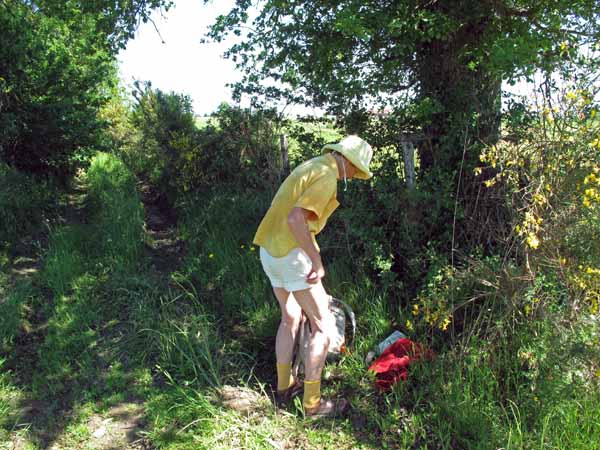
While we were luxuriating in front of our coffees, the speedy Dutchman Henk arrived. He had stayed for breakfast at the gîte with the Germans, who were coming along behind him, although very slowly. Nevertheless we expected to find them in front of us when we set off again, after yesterday’s performance.
Leaving the bar after this pleasant break, we walked down to the bottom of the street and took a small road marked with pilgrim signs.
An old couple tending their garden asked us whether we were pilgrims (“doing the Saint-Jacques”, as it is known) and how far we were going. “All the way”, I lied, to avoid having to explain the details of what we actually intended.

The road took us through abundant fields and we connected with the GR a couple of kilometres further on. For a while we continued on a road, but then we left the GR and took a descending lane beside a hedge.
It was a good opportunity for me to take off my long trousers and put on the shorts that I had been carrying for two weeks without once wearing.
While I was doing this, Henk came striding past and we thought he would be far ahead by the time we started off again, but almost immediately we caught up to him, wandering beside a wheat field.
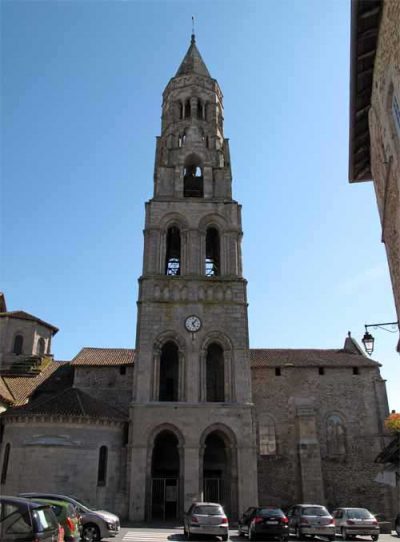
The farmer had roped off and ploughed up the track, leaving walkers to make their way as best they could. Henk was not carrying a map, relying on the GPS in his mobile phone, and was looking in vain for a pilgrim sign.
Our combined search eventually found one near the stream on the other side of the field, where there were a couple of abandoned water mills. In former times these had been used to grind various things – grain (for flour), tanbark (for tanning leather), wood pulp (for paper) and most recently clay (for Limoges porcelain).
As we climbed away from the stream, all three of us started to feel the heat of the summer sun. It was ungrateful to complain after all the rain and the slush, but we did anyway as we sweated our way uphill.
At the hamlet of Lussac we lost the pilgrim marks and found ourselves in a dead-end street, but with the help of the Topoguide we made our way to the D19 and then to the bigger D941, which took us up into the heart of Saint-Léonard-de-Noblat.
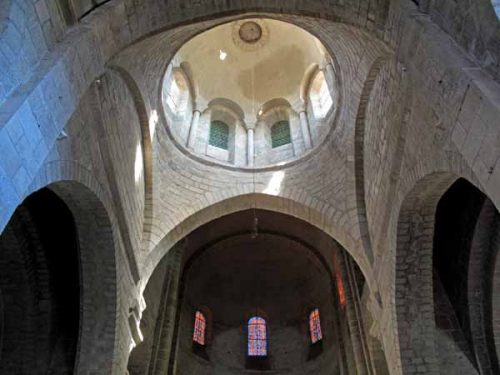
This town, like Bénévent-l’Abbaye, was an essential stopping place for the mediaeval pilgrim, a place to venerate Saint Léonard, who was the patron saint of prisoners and pregnant women. He was a Frankish nobleman of the late fifth century, whose father was at the court of king Clovis.
The young Léonard showed his first saintly attribute by interceding on behalf of certain prisoners and having them set free. Refusing all high office, he left the court and retired to live as a hermit on a forested hill, the site of the present town.
His second specialisation, pregnant women, derives from the legend of the queen of Aquitaine.
When the king was away hunting, she went into a difficult labour and was close to death, but through the power of Léonard’s prayers, she managed at last to produce a healthy child. The grateful king granted Léonard ownership of the land around his hermitage, and he stayed there for the rest of his life, performing many miracles.

The old town was at the top of the hill, ringed by a busy road. We walked along it until we came to a square with a bar-restaurant, where people were eating out of doors in the unusual warmth.
It was 12:30 and the Office of Tourism had just closed, but there was a list of accommodation in the window. There were only two hotels and no camping, so after taking in a coffee at the bar (Henk, being Dutch, had beer), we strolled around and booked in to the Relais Saint-Jacques, in adjacent rooms.
In luxurious seclusion we had our picnic lunch, followed by showers, clothes washing and a sleep. Both of us had severely damaged feet, but we were able to creep out later and look around the lanes of the lovely old town, all of which led to the church with its mighty steeple that we had seen from afar as we arrived.

We were not the only pilgrims at large – several were staying at the gîte near the church. We saw Henk in a square sharing a beer with one of them.
It was too painful to walk far, so we went back to the hotel and only emerged towards 8 pm in search of dinner. There was not much to choose from and after hobbling around for a while we ended up at the “Gay-Lussac”, a few steps from the hotel.
Gay-Lussac, the famous nineteenth-century chemist, was born in Saint-Léonard-de-Noblat. His main interest was in gases and he discovered that the volume of a gas is exactly proportional to its temperature.
He also discovered the elements boron and iodine, and floated up over 6 km above the earth in a hot-air balloon in the interests of science.
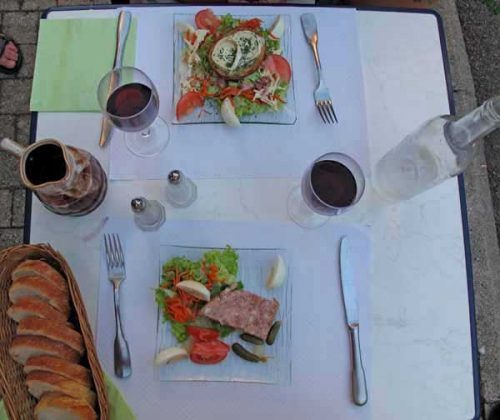
Although the menu seemed expensive at €19, it was the best we could find and the place had a pleasant terrace, already half-full of diners. Most of them turned out to be pilgrims of one sort or another, either cyclists or walkers.
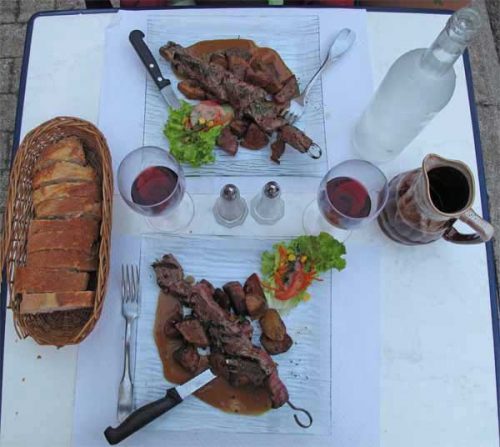
We began our meal with a terrine and a salad of chèvre chaud (with warm goat’s cheese on toast).
The main course was skewered pieces of beef, large and juicy, and for dessert we had magnificent profiteroles, as the clafoutis we had ordered had run out.

There was general conversation, in French and English, amongst the tables, as several people were eating by themselves, including Henk, who was almost finished by the time we arrived.
The locals were not dining out tonight (Saturday is usually their night), confining themselves to strolling through the square with their dogs.
After this convivial evening, we were thankful that we only had a short distance to limp back to the hotel.
Previous day: Bénévent-l’Abbaye to les Billanges